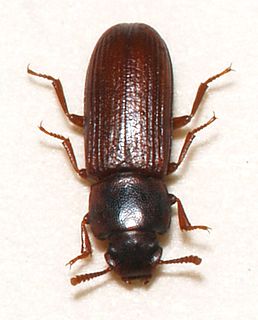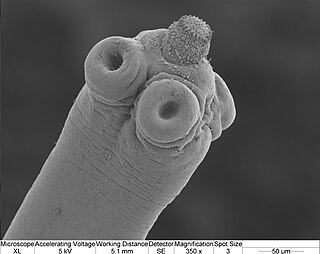Related Research Articles

Darkling beetle is the common name of the large family of beetles Tenebrionidae. The number of species in the Tenebrionidae is estimated at more than 20,000 and the family is cosmopolitan in distribution.

Bartonella is a genus of Gram-negative bacteria. It is the only genus in the family Bartonellaceae. Facultative intracellular parasites, Bartonella species can infect healthy people, but are considered especially important as opportunistic pathogens. Bartonella species are transmitted by vectors such as ticks, fleas, sand flies, and mosquitoes. At least eight Bartonella species or subspecies are known to infect humans.
Plasmodium wenyoni is a parasite of the genus Plasmodium. As in all Plasmodium species, P. wenyoni has both vertebrate and insect hosts. The vertebrate hosts for this parasite are reptiles.

Flour beetles are members of the darkling beetle genera Tribolium or Tenebrio. They are pests of cereal silos and are widely used as laboratory animals, as they are easy to keep. The flour beetles consume wheat and other grains, are adapted to survive in very dry environments, and can withstand even higher amounts of radiation than cockroaches. They are a major pest in the agricultural industry and are highly resistant to insecticides.

The confused flour beetle, a type of darkling beetle known as a flour beetle, is a common pest insect known for attacking and infesting stored flour and grain. They are one of the most common and most destructive insect pests for grain and other food products stored in silos, warehouses, grocery stores, and homes.

Tenebrioninae are a large subfamily of the darkling beetles (Tenebrionidae), containing, among others, the flour beetles.

The red flour beetle is a species of beetle in the family Tenebrionidae, the darkling beetles. It is a worldwide pest of stored products, particularly food grains, and a model organism for ethological and food safety research.

The Haemosporida are an order of intraerythrocytic parasitic alveolates.

Hymenolepis microstoma, also known as the rodent tapeworm, is an intestinal dwelling parasite. Adult worms live in the bile duct and small intestines of mice and rats, and larvae metamorphose in the haemocoel of beetles. It belongs to the genus Hymenolepis; tapeworms that cause hymenolepiasis. H. microstoma is prevalent in rodents worldwide, but rarely infects humans.
Zerknüllt is a gene in the Antennapedia complex of Drosophila and other insects, where it operates very differently from the canonical Hox genes in the same gene cluster. Comparison of Hox genes between species showed that the Zerknüllt gene evolved from one of the standard Hox genes in insects through accumulating many amino acid changes, changing expression pattern, losing ancestral function and gaining a new function.
Alexander Sokoloff was a biologist and geneticist who conducted genetic research on the red flour beetle Tribolium castaneum, a world-wide pest species. From 1965 to 1990 he was a Professor of Biology at California State University, San Bernardino, serving for part of that time as Department Chair.
Parvilucifera is a genus of marine alveolates that parasitise dinoflagellates. Parvilucifera is a parasitic genus described in 1999 by Norén et al. It is classified perkinsozoa in the supraphylum of Alveolates. This taxon serves as a sister taxon to the dinoflagellates and apicomplexans. Thus far, five species have been described in this taxon, which include: P.infectans, P.sinerae, P.corolla, P.rostrata, and P.prorocentri. The genus Parvilucifera is morphologically characterized by flagellated zoospore. The life cycle of the species in this genus consist of free-living zoospores, an intracellular stage called trophont, and asexual division to form resting sporangium inside host cell. This taxon has gained more interest in research due to its potential significance in terms of negative regulation for dinoflagellates blooms, that have proved harmful for algal species, humans, and the shellfish industry.
Farinocystis is a genus of parasitic alveolates of the phylum Apicomplexa. Species in this genus infect insects (Coleoptera).

Tribolium is a genus of flour beetles in the family Tenebrionidae.
The Diplocystidae are a family of parasitic alveolates in the phylum Apicomplexa.
Apicystis is a genus of parasitic alveolates of the phylum Apicomplexa.
Metavirus is a genus of viruses in the family Metaviridae. They are retrotransposons that invade a eukaryotic host genome and may only replicate once the virus has infected the host. These genetic elements exist to infect and replicate in their host genome and are derived from ancestral elements unrelated from their host. Metavirus may use several different hosts for transmission, and has been found to be transmissible through ovule and pollen of some plants.
A storage pest is an insect or other animal that damages or destroys stored food or other stored valuable organic matter. Insects are a large proportion of storage pests with each type of crop having specific insects that gravitate towards them such as the genus Tribolium that consists of insects such as Tribolium castaneum or Tribolium confusum which damage flour crops primarily.
Cytochrome P450, family 15, also known as CYP15, is an animal cytochrome P450 family found in insect genome, involved in juvenile hormone biosynthesis. The first gene identified in this family is the DpCYP15A1 from the Diploptera punctata, encodes an epoxidase of methyl farnesoate, a precursor of juvenile hormone, alone with its ortholog TcCYP15A1 in Tribolium castaneum.
Cephalonomia tarsalis is a idiobiont ectoparasitoid hymenopteran in the family Bethylidae. Known hosts include: Oryzaephilus surinamensis, Sitophilus granarius, Sitophilus oryzae, Sitophilus zeamais, and Tribolium castaneum.
References
- ↑ Ashford RW (1965). "Lymphotropha triboliigen. nov., sp. nov., Neogregarinida, Schizocystidae, from the haemocoele of Tribolium castaneum (Herbst)". J Protozool. 12 (4): 609–615. doi:10.1111/j.1550-7408.1965.tb03263.x.
| | This Apicomplexa-related article is a stub. You can help Wikipedia by expanding it. |